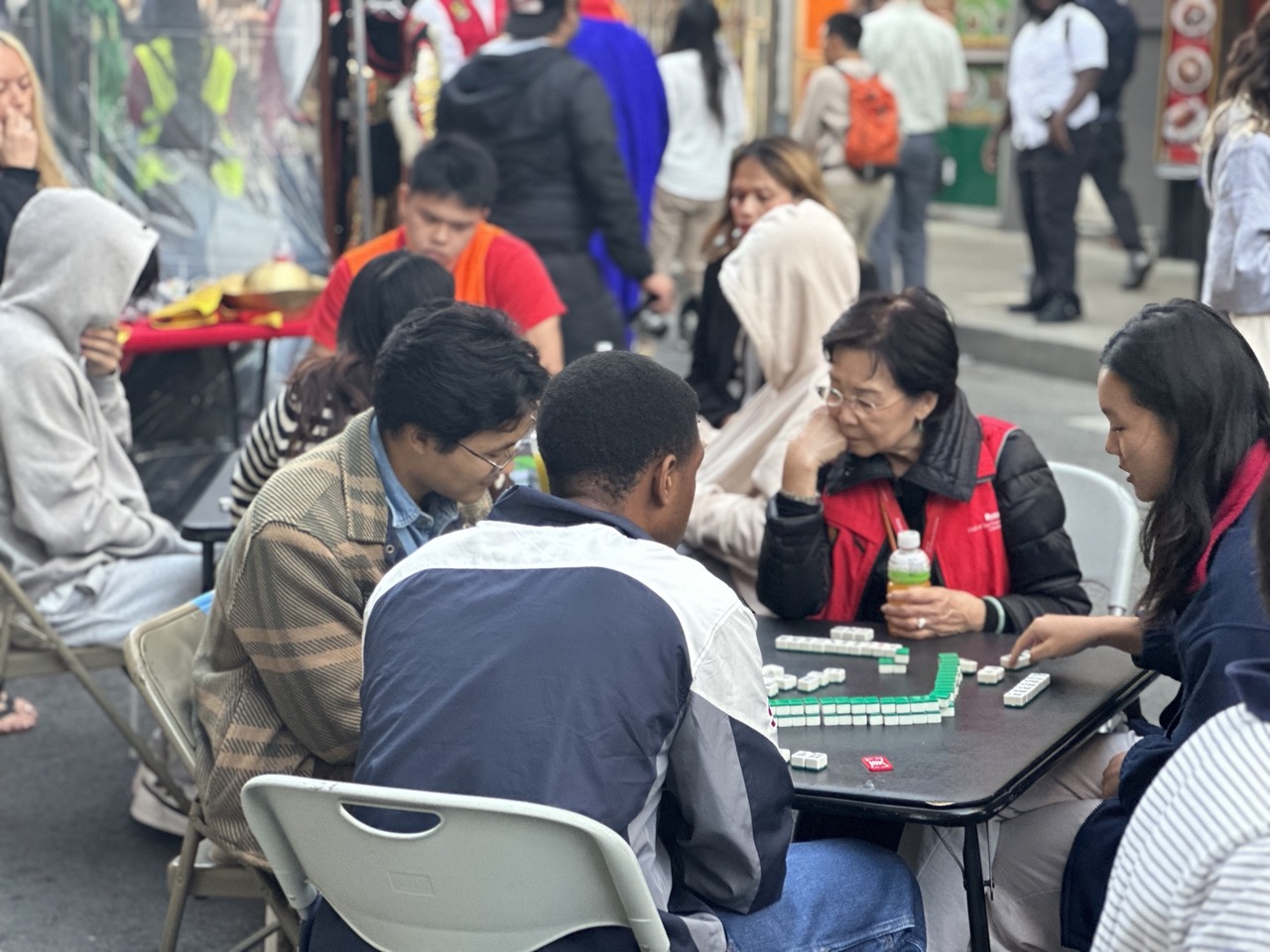Xinling Wang avoided San Francisco’s Chinatown for years.
When she first came to the United States three years ago as an international student, the general advice was: If you want to adapt and thrive here, you should not linger in Chinatown.
But Wang finds herself drawn back again and again. She’s been putting up art installations in alleys, painting murals, organizing a zine festival.
Young cultural workers are organizing events and making art designed to draw their peers to the oldest Chinatown in North America. They have launched a monthly night market, arranged cultural festivals that depart from traditional heritage themes, and created spaces like a curated store showcasing Asian and Pacific Islander culture.
These changes reflect a broader effort to reimagine the neighborhood as Chinatowns across the country are aging and shrinking. Even before the COVID-19 pandemic, local leaders were looking for ways to keep local culture alive as older entrepreneurs retired without successors to carry on their legacies. They supported new galleries and festivals to fill the gap left by the loss of tourism, while trying to protect the neighborhood’s status as a home for low-income immigrant families and seniors. As new arrivals, each with their own motivations, look for their place in the neighborhood, they must engage with an already established and diverse community.
Filling the streets with life
On the second Friday of each month, as night approaches, dim sum booths, performance stages and mahjong tables pop up along the pavement in Chinatown. The area between them is packed with a chattering crowd. Jonathan Sit, co-organizer of Chinatown’s night market, is in charge of the logistics, and directs a volunteer crew to block off auto traffic and transform the road into a bustling space for wholesome fun.
The neighborhood at night is filled with energy now, a stark contrast to when Sit, co-founder of the Chinatown Volunteer Coalition, was here five years ago. Back then, the streets were nearly empty, with only a few cars drifting by. Sit, a structural engineer by profession, would patrol the sidewalks, staying alert for signs of trouble, ready to deter and defend against break-ins targeting Asian-owned shops during the pandemic.
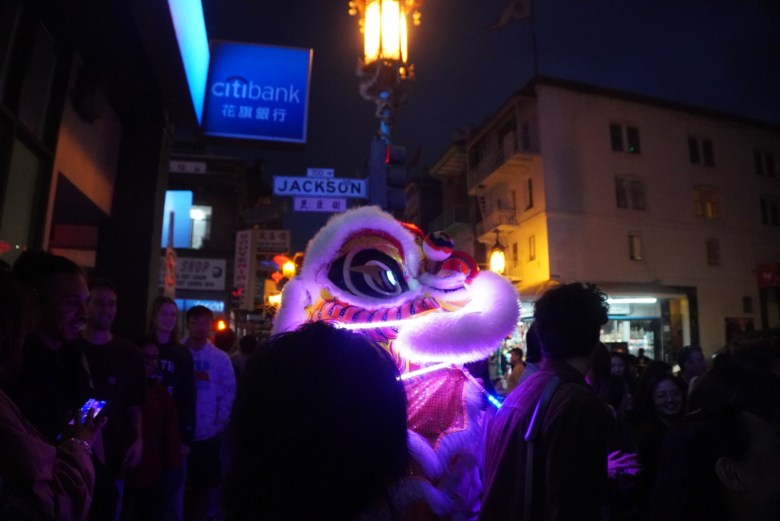 Dragon dancers perform in the Chinatown streets. Jason Winshell / San Francisco Public Press
Dragon dancers perform in the Chinatown streets. Jason Winshell / San Francisco Public Press
The night market, which launched just three years ago on Grant Avenue, Chinatown’s main roadway, was recently ranked the top night market in the country by USA Today and inspired a similar effort in Oakland’s Chinatown.
Sit has been trying to push back against stereotyping Chinatown as only for old people, kids and tourists. Yet he admitted that he once held this idea, too. As a child, he spent much of his time in the neighborhood, but stopped coming as he got older, went to college and started his career.
For families who started their immigration journey in Chinatown, “the goal is always to get out,” said Max Leung, who called himself a “Chinatown kid.” He left the area while in high school, when both his family and their bakery businesses moved to the city’s west side.
While San Francisco’s Chinatown is best known as a tourist destination, it remains home to many immigrants. With jobs that don’t require fluent English and relatively low-cost housing, the neighborhood has long served as a landing spot for monolingual Cantonese speakers starting new lives in the country. But the conditions that draw people can also push them out. With few family-sized units available, most housing available here consists of cramped single-room occupancy units. That is “not the kind of place where you want to raise a family,” said Leung, though many families still have no choice but to do so.
Sit’s volunteer team is a new presence in the neighborhood, made up of Asian Americans in their 20s and 30s who, like him, began spending more free time in the neighborhood during the COVID pandemic. They organized events and explored local businesses, making social media videos of themselves hanging out there.
In one video, the host shows the team enjoying a meal around a table at a Chinatown restaurant, listing the dishes they ordered. She gives special attention to the restaurant’s specialty, clay pot rice, a classic Cantonese dish. The video drew hundreds of likes on Instagram.
They hoped to shift the mindset of peers who rarely visit, who might feel the neighborhood “isn’t a place for them,” said Sit.
Coming back to Chinatown to protect it
For many older immigrants, leaving this monolingual Chinese enclave and having their kids assimilate into mainstream American culture signals they’ve “made it,” Leung said.
Leung was first to organize volunteer street safety patrols in Chinatown, something he still participates in. He didn’t expect to return to Chinatown this way, until xenophobic scapegoating during the pandemic, including from President Trump, fueled a surge in attacks on Asian-owned businesses and individuals.
“If there was no threat to Chinatown, if we knew that, ‘oh, Chinatown is fine, and it’s gonna be here, no matter whether we do anything or not,’ then people might not be activated,” he said.
While many in his generation returned out of a sense of urgency and to respond to a rising incidence of attacks, more are choosing to stay to confront a deeper crisis: the loss of foot traffic after tourism dried up during COVID. Having once guarded the streets from bad actors, they are now organizing events to draw people. Leung, for example, is one of the go-to DJs for the monthly night markets and cultural festivals.
He sees this as meaningful for the younger generation. “Many have become a little detached from their culture and community; they’re longing for that sense of identity and pride,” he said.
Leung and Sit, in their mid-50s and 30s respectively, are slightly older than volunteers with few ties to the neighborhood and thus can bridge the immigrant and youth communities. Tensions have arisen in the past: The popular night market drew complaints that long hours of street closures blocked parking and residents’ access to their homes.
Sit tried to bridge some of the gaps. He speaks Cantonese and his family ties to an important local association afford him a deep knowledge of the area. His volunteer group has brought young people together with longtime residents to build relationships. So when someone wants to organize an event like a mahjong night, they turn to him for venues and connections.
New group of young people stepping up
Since the Great Star Theater reopened in 2021, every once in a while, a Chinatown local would linger outside, hoping to start a conversation. That’s when Alice Chu, the only team member who can speak Chinese, would be called out to help translate.
The venue, brought back to life by Chu and her husband, Roger Pincombe (who is not of Chinese descent), after its closure during the pandemic, is the only remaining stage theater in Chinatown.
Chu learned through those conversations how much the locals cherished the Great Star.
When Chu and Pincombe took over the theater, she hadn’t expected to get so involved. She even tried to talk him out of the project, worrying about the cost of running such a large space.
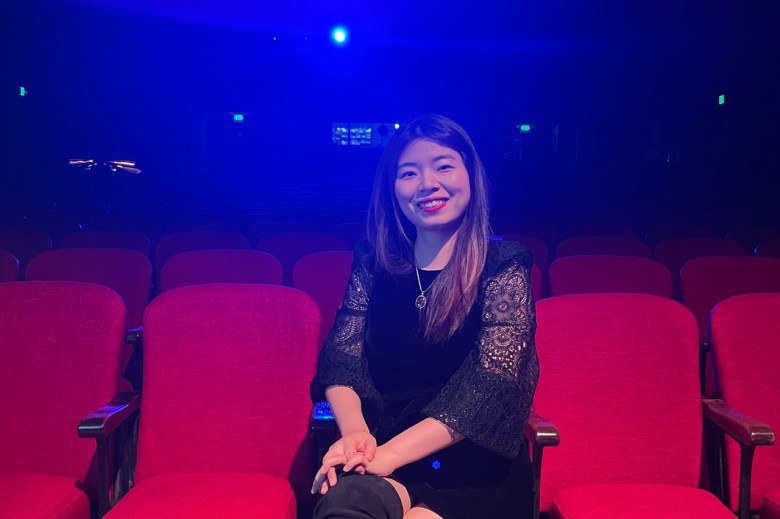 Alice Chu inside the Great Star Theater. Credit: Courtesy Alice Chu
Alice Chu inside the Great Star Theater. Credit: Courtesy Alice Chu
She also felt little connection to the area before taking over the theater. Even after living in the United States for more than 10 years, Chu often felt out of place in society as a woman of color and an immigrant. For a long time, she struggled with her accent, knowing she would never sound like a native English speaker. “But since coming to Chinatown, my English with a Chinese accent and my ability to speak Chinese have become a plus,” she said.
“I never thought my identity would be good, but after coming here, I see the value of it,” she said.
Many other culturally significant businesses in Chinatown are struggling: Only one banquet hall remains for large events like weddings and holidays, and nearly all of the neighborhood’s Chinese-language bookstores shut down permanently during COVID.
Local leaders say the loss is due in part to store owners retiring. While some of their children have chosen to leave their careers to take over the family business, many do not, especially since these mom-and-pop businesses often require hard physical labor.
Local leaders like Vincent Pan, executive director of Chinese for Affirmative Action, worry about cultural displacement from the area. Pan said that even before the pandemic, more blocks on Grant Avenue, the tourist corridor, were being taken over by storefronts unrelated to the neighborhood’s legacy.
His group partnered with five other nonprofits in 2018 to form the Chinatown Media & Arts Collaborative, aiming to reinsert local culture into brick-and-mortar spaces around the neighborhood. That effort includes opening a gallery dedicated to Asian American art on Grant Avenue.
Groups and individuals not part of the collaborative also have been working to preserve and pass on the neighborhood’s heritage. Poet Clara Hsu transformed the building that once housed her musical instrument store into a performing arts center, where youth connect, practice Cantonese and take the stage. Philanthropist Florence Fang has founded two museums educating visitors on Chinese American history.
That work has had ripple effects. Aaron Wang, a 33-year-old tech worker, hatched a plan to open a Chinese-language bookstore earlier this year but didn’t have a location in mind. After he attended an event in Chinatown and spotted a “for rent’” poster, he started connecting with local nonprofits and residents. When he learned of nearly all the Chinese-language bookstores in the area that had closed, he realized his venture could fill an important niche in the community. The bookstore, called Unbound, is slated to open in Chinatown in late October.
“I feel a sense of mission when I talk with them,” said Wang. “It’s like passing the torch to our young people, who can carry on this work and bring more of them back to the area.”
Finding space and balance
Unlike many young people returning to Chinatown recently, Rosa Chen has lived there her entire life. She recalls not enjoying it as a child and wanting to explore other neighborhoods. But as she learned more about its history through some high school volunteer work, she developed a deeper connection..
“For community folks, they want to see young people come back, because you need young folks to help sustain and keep the neighborhood alive,” said Chen, now the program director at Chinatown Community Development Center, a local affordable housing developer.
Chen said longtime residents welcome younger people who want to sustain the culture to come back with new ideas and perspectives. But she added that Chinatown is a diverse community, with varying needs and visions.
“There’s always conflicts about any new idea that shows up,” Chen said, though she cautioned against oversimplifying those tensions; they are more complex than older people resisting change while younger newcomers want to reinvent everything.
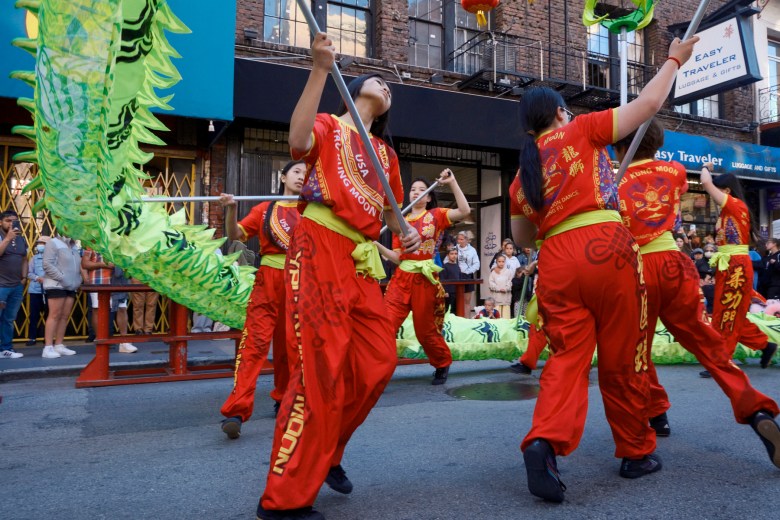 Dancers perform at the Chinatown Night Market on August 8, 2025. Credit: Jason Winshell / San Francisco Public Press
Dancers perform at the Chinatown Night Market on August 8, 2025. Credit: Jason Winshell / San Francisco Public Press
Conflicts have arisen. For example, last year, LionDanceME, a group supporting young performers, closed part of Grant Avenue for lion dance practice to create opportunities for kids and attract visitors. Merchants pushed back, saying the closure lasted too long and blocked parking for customers and residents. Both sides brought the dispute to the city Board of Appeals.
“It’s a matter of how you communicate,” Chen said. “Are we truly a happy community if there is no discourse with one another?”
Space is at a premium
Much of Chen’s work now is to ensure the large senior population in the area can stay.
Chinatowns across the country face development that encroaches on residential areas, driving up prices and forcing residents and small businesses to leave. In New York, the community is fighting a proposed megaprison, while the Chinatown in Philadelphia recently ended a three-year battle against a new basketball arena.
In San Francisco, Chen said, tight restrictions on development have kept Chinatown affordable as gentrification has driven up prices nearby.
But the neighborhood faces different challenges: old buildings, an aging population, and stores struggling to keep up with customers’ interests while staying true to the cultural identity of the area.
Steven Lee, who has spent years bringing businesses to Chinatown, said declining foot traffic combined with high rents make it difficult to attract young entrepreneurs.
Support our local in-depth reporting and investigations.
Lee noted that over the years, some young Chinese Americans have returned after gaining experience elsewhere. Cynthia Huie, who previously managed a business in Inner Richmond, opened a gift shop highlighting Asian and Pacific Islander designers and authors. Brandon Jew launched the city’s first Michelin-starred Chinese American restaurant after honing his culinary skills abroad. Lee himself, who once ran a nightclub in the South of Market neighborhood, opened the first nightclub in Chinatown in decades.
“The residents don’t have the spending power” to sustain all Chinatown businesses, Lee said. So business owners rely on attracting visitors, once mostly tourists, now often locals from nearby neighborhoods. This also means businesses need to offer something unique to the area, not just cheap merchandise found anywhere.
Not all those ideas can land here easily.
When artist Xiangqi Chen first visited Chinatown about a decade ago she was fascinated by how the community values and keeps its cultural heritage. Last year, she arranged a pop-up exhibition, Outmuseum, that documented the disappearing history of LGBTQ+ communities in mainland China. The nonprofit Chinese Cultural Center helped her organize the exhibit. After the event, she kept returning, learning to perform Cantonese opera and exploring the often hidden queer experiences in the area.
“Chinatown is like a sponge,” Chen said in Mandarin. “At different times, young people, or anyone, can be like a drop of water soaking into it.”
Her plan to secure a permanent location for the Outmuseum remains on hold. Earlier this year, her attempt to open a storefront in collaboration with a local organization fell through after the group lost its federal funding and finding a suitable storefront has proven difficult.
Wang, the artist who arrived in San Francisco as an international student, has a similar story. She has built strong ties with local store owners, nonprofits and community leaders as she developed her thesis project, centered on her identity in the neighborhood. As part of an exhibition, she redesigned a mailbox in a local alley, expressing her struggles with job hunting and visa status through an installation in this immigrant hub.
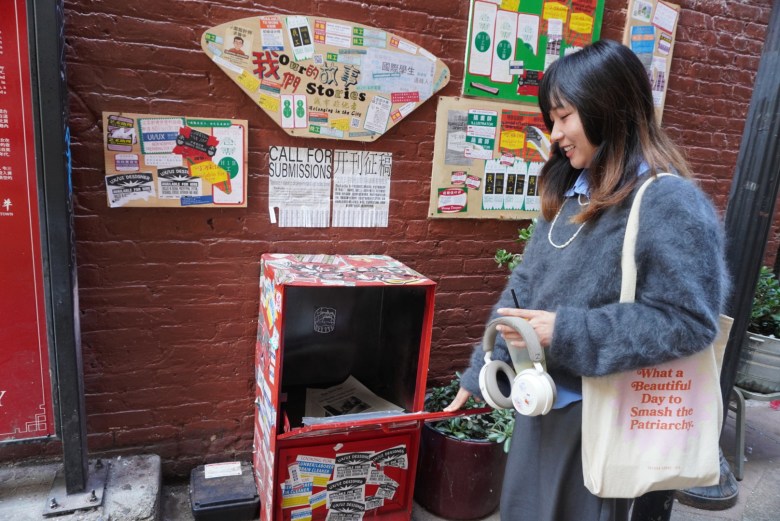 Xinling Wang opens the mailbox she decorated as part of a public art installation. Credit: Zhe Wu / San Francisco Public Press
Xinling Wang opens the mailbox she decorated as part of a public art installation. Credit: Zhe Wu / San Francisco Public Press
But Wang faces difficulty finding work in the area as an international artist who needs visa sponsorship. She’s uncertain how much longer she may stay.
Nonetheless, the efforts of these cultural workers are drawing attention.
Seventy-three-year-old Kwan Ping Low has lived in Chinatown for more than 40 years. She enjoys seeing new events. At the Hungry Ghost Festival in August, organized by the Chinese Cultural Center, she had her iPad out, recording everything to relive later.
Since Sit organized the night market, he’s been fielding questions from older community members. Many immigrant parents still hope their kids move out for college and better careers, he said, but some of the elders have expressed sadness about those departures. And even a few of those who once urged their kids to move on seem hopeful about the renewed interest in the neighborhood.
“My mom was actually happy,” Sit said. “She doesn’t know how much I do, but she knows I’m doing things that’s beneficial for people.”
Keep up to date — get the latest news in your inbox weekly!
Related

